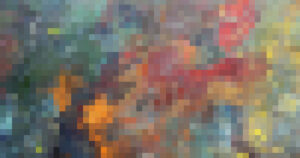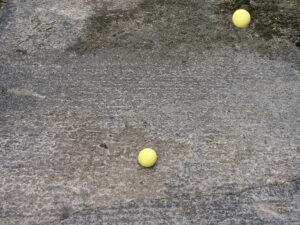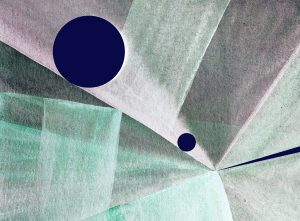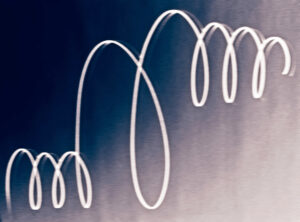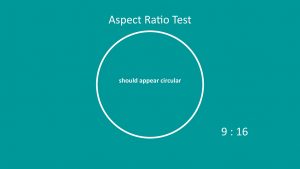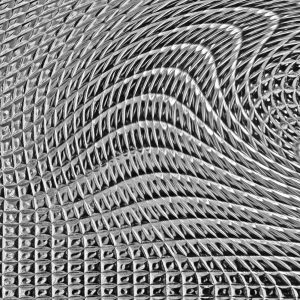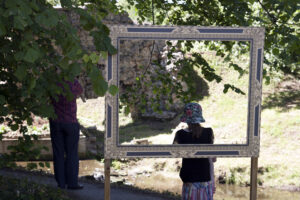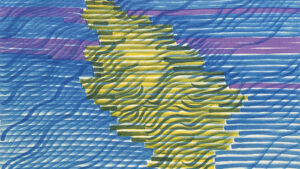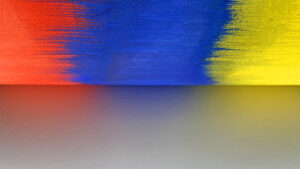
In algebra, a discontinuous function is one that cannot be drawn with a single stroke of a pen because the curve that represents the function has one or more gaps in it. In this sense then most visual art is discontinuous, only works with a single continuous line or area would fall outside the algebraic definition. It can be seen then that algebraic discontinuity has been hugely important in the production of the vast majority of works.
However, in art there are at least two other forms of discontinuity that are arguably even more Important. These occur in the development of new work and concepts as discussed briefly here and also within works, when it might be regarded as the creation of a discontinuous system.
Dealing with the latter case above, the source of discontinuity within a work can either be through the choice of elements as the means of expression, such as lines, colours, shapes, etc., which are not necessarily directly related to each other or introducing multiple perspectives within the work. So, whilst areas of the image can be read on their own, the juxtaposition of two or more perspectives breaks from any tradition of portraying something which does or could exist as a real object or place.
In both of the above cases the effect of discontinuity is to interfere with the meaning-making (semiosis) of the viewer.
The study of Semiosis, semiotics, is a relatively new field compared to other branches of science and humanities. Whilst there is still considerable debate within the field about how semiosis happens the basics are broadly accepted to be that the process requires three elements: a sign, an interpretant and a signified (meaning). One of the areas of debate is whether the meaning can be a feeling and hence whether a sign can directly imply a feeling or whether any feeling comes from the process of interpreting the sign into a meaning and the feeling comes from an association by the interpretant with the meaning derived.
Initially work in semiotics focussed on linguistics, the study of language, its words and their usage. More recently the underlying principles have been applied in other fields and more widely than just in Humans. The interest here is the application of semiotics in the field of contemporary art, in particular what does semiotics mean for the viewer of a work?
First, we have to consider how meaning gets into an image. Where does it start and where does it end? Roland Barthes[1] contends that the signs within an image are all discontinuous but we assume they form a coherent whole. We are required to ‘read’ the image. He also asserts that there is an assumption that a photograph is a recording of nature, a trap which can easily be fallen into when viewing all visual art. In his work the Rhetoric of the Image[2] he uses a photographic image of an advert as the subject of his analysis and shows the meaning of the choice of the elements and the composition.
When presented with an image the typical process that the viewer or more accurately the viewer’s brain (the interpretant) goes through, normally at a subconscious level, is to parse the image and identify its constituent elements (signs) and their juxtaposition. This is, of course, in part at least limited by the knowledge and previous experience of the interpretant. You have to have previously seen or know the description of a sign or signified to know what it is.

Corners of the Sphere, 2023
Coloured pencils on paper, 43 x 67
Charles Sanders Peirce[3] undertook a significant body of work in the field in the nineteenth century. He used the word ‘object’ rather than ‘signified’ in his work, where object is meant as in language (Subject, Verb, Object). Which introduces the concept of Syntax from the linguistic world. To extract meaning subsequent to the parsing there needs to be some form of rules or conventions commonly understood by a cohort for any meaning to be transmitted from one individual to another.
Peirce also proposed that a sign can be one of three sub-types signs that are semblances (that is a direct representation of an object), symbols (that is they are used to represent something) and indices, (that is signs which indicate the presence of something else, not necessarily seen, such as smoke indexing fire). There is the possibility that a sign can be dual or triple purposed, that it can be simultaneously of more than one-sub-type.
Even if a sign is of only one sub-type, the second potential limitation (or delight) when, having parsed the image and moving to deciphering meaning is whether any particular sign has more than one meaning, as is frequently the case with words. Then there is the question of juxtaposition of the images, composition if you like. What meaning(s) might the particular composition chosen have?
A final component in the process of deriving meaning is context, both at a macro and micro level. The norms of a culture form part of the syntax at the time of interpretation. If they differ then what is meaningful in one culture can be devoid of meaning in another or mean something entirely different. Something viewed favourably in one can be viewed unfavourably in another. At the local level the positioning of the image in a particular space, or indeed its juxtaposition to others adds to the complexity of the interpretation process and the richness of the possibilities.
From the above it can be seen that the breadth of knowledge of the interpretant, their range of previous exposure to various bodies of work and the context in which they are viewing all play a part in the derivation of possible meanings and the triggering of feelings.
By introducing discontinuity into a work two things might result. Since it interrupts the parsing and meaning-making of the interpretant it can baffle, distress or confound. On the other hand, since the human brain is adept at filling in spaces in presented information and deriving a meaning in the absence of a complete or coherent set of information, it can create extra space in which new things can be imagined and hence experienced.

Discursive, 2015
Collage, ink on paper
Circling back to the question of whether signs can signify a feeling, we might reasonably ask whether the intent of any particular work is to convey or invoke meaning or feeling (That’s four possibilities). Depending on the answer what does introducing discontinuity do in each case?
Decorative objects are designed to invoke a (normally pleasant) feeling in the viewer, they are different from works that are designed to convey a feeling of the creator by invoking a feeling in the viewer. Different again from works that are designed to convey a meaning to the viewer. Of course, it is possible sometimes to invoke a feeling, convey a feeling and convey a meaning simultaneously, sometimes by intent sometimes by chance.
If the intent is to convey meaning or feeling it can be considered disruptive to the process as the discontinuity interrupts the meaning-making which can obscure the intended message. However, if the intention is to invoke feelings it can be argued that the function of discontinuity is to open up new possibilities, since what is supplied by the interpretant to fill in the gaps is infinite or at least only bounded by the entire collective knowledge and experiences of the viewers.
[1] Roland Barthes – (1915 – 1980) was a French literary theorist, essayist, philosopher, critic, and semiotician. His work engaged in the analysis of a variety of sign systems, mainly derived from Western popular culture. His ideas explored a diverse range of fields and influenced the development of many schools of theory, including structuralism, anthropology, literary theory, and post-structuralism.
[2] Barthes, R., 1999. Rhetoric of the Image. Visual culture: The reader, pp.33-40.
[3] Charles Sanders Peirce – (1839 – 1914) was an American philosopher, logician, mathematician and scientist.
